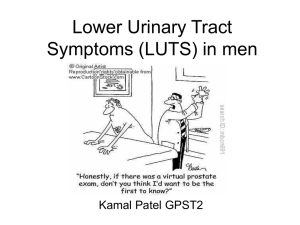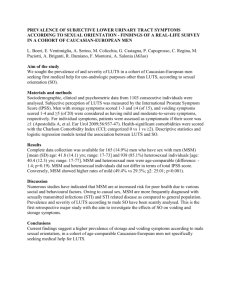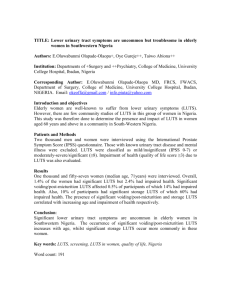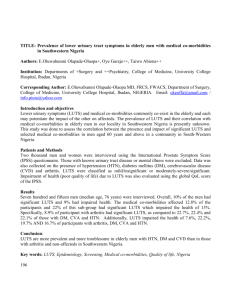Presentation slides for Dr. Jill Macoska
advertisement
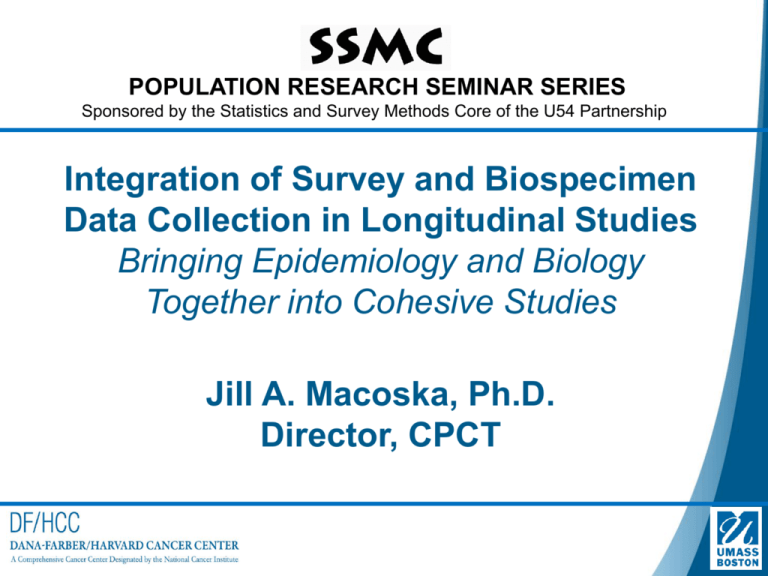
POPULATION RESEARCH SEMINAR SERIES Sponsored by the Statistics and Survey Methods Core of the U54 Partnership Integration of Survey and Biospecimen Data Collection in Longitudinal Studies Bringing Epidemiology and Biology Together into Cohesive Studies Jill A. Macoska, Ph.D. Director, CPCT Biology and Epidemiology: Cause and Effect Biology: ▸ The science of life or living matter in all its forms and phenomena = CAUSE (End Here) Epidemiology: ▸ The branch of medicine dealing with the incidence and prevalence of disease in large populations = EFFECT (Start Here) Epidemiology demonstrates observational connections, Biology establishes causal connections. Types of Epidemiological Studies Cross-sectional: Study is conducted at a single time point. Comprises observation of one or more variables at single period of time. Longitudinal: Study is conducted at multiple, consecutive time points. Comprises repeated observations of the same variables over long periods of time. Types of Epidemiological Studies: Examples Cross-sectional: ▸ Study percentage of obese individuals in a given population. ▸ Randomly sample 1,000 individuals, measure weight and height, calculate % of obese individuals. ▸ Results: Individuals in Ohio are more obese than those in Massachusetts. Obesity Rates in U.S. Populations: By State OH: 11-14% MA: <10% Types of Epidemiological Studies: Examples Longitudinal: Study obesity trends in a given population. Recruit 1,000 individuals, measure weight and height at one-year intervals over 10 years, calculate obesity rates over time. Results: Obesity rates doubled in both Ohio and Massachusetts in 25 year period between 19852010. Obesity Rates in U.S. Populations: By State OH: 11-14% MA: <10% OH: 25-29% MA: 20-24% Example: Longitudinal Study of BPH and Lower Urinary Tract Symptoms (LUTS) Bladder Normal Prostate Normal Urine Flow Bladder Enlarged Prostate Obstructed Urine Flow (Experienced as LUTS) The Olmsted County Study of Urinary Symptoms and Health Status Among Men ▸ Initiated in 1990 to determine the natural history of Benign Prostatic Hyperplasia (BPH) in the community. ▸ Association of BPH with age suggested that a longitudinal study design would be most optimal. ▸ A sampling frame was developed using the resources of the Rochester (Minnesota) Epidemiology Project: Identified male residents of Olmsted County 40 to 79 years old on January 1,1990. ▸ 3,658 men were identified. The Olmsted County Study of Urinary Symptoms and Health Status Among Men Of these men, 2,115 (55%) 1990 3,658 1992 1994 completed the study protocol: • Personal interview to elicit a family history of urological disease and current medications; • Completion of a self administered questionnaire: lower urinary tract symptoms, basic demographic information and psychological well-being, • Measurement of urinary flow rates with a portable uroflowmeter. The Olmsted County Study of Urinary Symptoms and Health Status Among Men • 25% of total cohort each round were invited to participate in a clinical urologic examination (clinic cohort): • Uroflow measurements, • Transrectal and transabdominal ultrasound, • Venipuncture and blood collection • Brief focused physical exam • Serum PSA measurement. • 80-90% of those invited completed the exam. Inclusion of Blood Collection in Protocol Permitted Biological Studies Based on Epidimiological Data Several Studies Associate Inflammation With LUTS Rodrigues-Nieves et al., Nat Rev Urol. 10:546-50 (2013) Olmsted Epid/Bio Study: Serum C-reactive Protein • C-reactive protein was measured in blood samples from 1996 cohort (Round 4). • Urologic symptoms compared in men between 1996 (Round 4) and 2004 (Round 8). • Men with CRP levels of >3.0 mg/L were more likely to have rapid increases in irritative LUTS and rapid decreases in peak flow rates compared to men with lower CRP levels. • Suggests that serum C-reactive protein may be a biomarker for risk of LUTS development and progression. • Suggests that inflammatory processes may be associated with LUTS development and progression (BIOLOGY) St. Sauver et al., Am. J. Epidemiol. 169:1281–1290 (2009). Olmsted Epid/Bio Study: PTGS2 Gene Variants • Inflammation observed as pathobiology concurrent with BPH • COX2 activity promotes inflammation; also promotes BPH? (hypothesis) • PTGS2 gene encodes COX2 • Are PTGS2 variants associated with increased RNA stability (and more COX2) also associated with BPH? Olmsted Epid/Bio Study: PTGS2 Gene Variants ▸ DNA was purified from blood collected from 356 Round 8 men (2004) and assessed for PTGS2 SNPs (also assessed for SNPs for 27 other inflammation-associated genes; results from all these were negative) ▸ Of 10 PTGS2 SNPs investigated, 4 were significantly associated with prostate volumes >30 mL and 1 of these (rs4648261) was also associated with prostate volumes >40 ml ▸ NSAID use (anti-inflammatory) minimized these associations Olmsted Epid/Bio Study: Serum Steroids ▸ Steroid hormones (testosterone) are the main growth factor of the prostate. ▸ Are high levels of steroid hormones evident for men with progressive BPH? ▸ Blood from Round 2 (1992) men was assayed for serum steroid hormone levels and urologic measures from Round 2 (1992) and Round 9 (2006) compared. ▸ Results: higher baseline and increased rate of change in sex steroid levels were associated with worsening LUTS: Serum testosterone decreases with increasing age and LUTS; serum estradiol increases with increasing age and LUTS. Biological implications under investigation. St. Sauver et al., BJU International 108: 1610-1615 (2011). Integrating Biospecimen Collection Into Longitudinal Survey-based Studies Biospecimen collection can be pursued for a subgroup of individuals recruited into longitudinal studies. ▸Cuts down on costs of collection and storage. ▸Provides sufficient power to ask relevant biological questions. ▸Easiest accomplished for relatively noninvasive biospecimen collection: buccal swabs, urine, saliva, blood. “Letting The Data Speak" – Testing Epidemiological Associations Through Biological Studies Epidemiology: British Doctor’s Study – 1951-2001 1956: statistical proof that tobacco smoking increased the risk of lung cancer (=EFFECT) Biology: • There are more than 45 known or suspected chemical carcinogens in cigarette smoke (=CAUSE) • Some of these impair DNA damage repair mechanisms and cause gene mutations (e.g., p53 gene mutations) Longitudinal Studies Design: Beginning, Middle, End (and Length!) Length of study depends on many variables: ▸Pathobiology of interest (short- vs longterm disease development and progression) ▸Population of interest: ▸ Community (static vs fluid) (longer studies) ▸ Clinic (shorter studies) ▸Funding (!) ▸Study team (stable/short-term) Early Detection of Recurrent Breast Cancer Using Metabolite Profiling • • • • • Clinic Based Longitudinal Study (5 years) 56 breast cancer patients enrolled All patients received surgery; 20 recurred, 36 No Evidence of Disease (NED); All followed ~ 5 years with annual sequential blood draws Asiago et al., Cancer Res. 70:8309-8318, 2010. Early Detection of Recurrent Breast Cancer Using Metabolite Profiling Asiago et al., Cancer Res. 70:8309-8318, 2010. Early Detection of Recurrent Breast Cancer Using Metabolite Profiling Cases (patients with recurrence) Asiago et al., Cancer Res. 70:8309-8318, 2010. Controls (no evidence of disease) POPULATION RESEARCH SEMINAR SERIES Sponsored by the Statistics and Survey Methods Core of the U54 Partnership Questions? Comments? Type them in or ask over your webcam/microphone Or send an email to u54.ssmc@gmail.com
